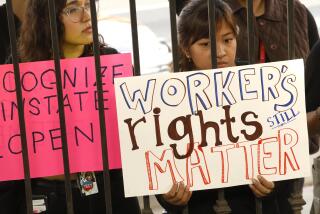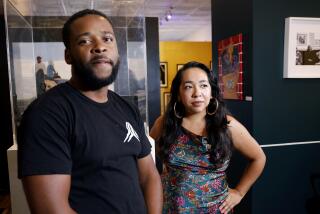These living history museums want YOU!
- Share via
WILLIAMSBURG, VA. — The breathless horseman who galloped down Duke of Gloucester Street bearing news of the battles of Lexington and Concord seemed to have ridden straight out of the 18th century.
His long hair was pulled back in a ponytail. He wore a tricornered hat and knee breeches. His burnt-orange cutaway coat flapped in the breeze. He was an authentic Virginia Colonial down to the square buckles on his shoes.
But the wire-thin microphone that wrapped around his chin was purely 21st century.
The rider is one of 31 actors who are part of “Revolutionary City,” a two-hour series of vignettes acted out daily on the streets of Colonial Williamsburg. The street theater is at the heart of a $220-million effort to freshen up the 81-year-old outdoor museum in hopes of reversing a decline in attendance.
With 301 acres and more than 3,200 employees, Colonial Williamsburg is the largest living-history museum in the United States, but its troubles are shared by many history museums that also have reported skimpier audiences in recent years.
Museum officials blame the lower numbers on several factors, including the Sept. 11 terrorist attacks, higher fuel prices, shorter attention spans, a decreased emphasis on teaching history in schools and increased competition from elaborate amusement parks.
Their solutions revolve around one idea: Grab the visitor’s attention early, and don’t let go.
“We are creating a form of outdoor pageantry that hasn’t been tried anywhere else,” said Rex Ellis, the Colonial Williamsburg executive in charge of the site’s historic area, which includes 88 buildings from the 18th and early 19th centuries. “We want to turn this history in every way possible so that whatever your learning style is, you can make a connection to the Colonial period.”
About 150 miles north at Mount Vernon, the attention-grabbing starts in an education center that opened last fall on the grounds of George Washington’s home.
Capitalizing on the popularity of TV shows like “CSI,” the center lets visitors see a forensic lab where a video presentation shows how scientists re-created Washington’s face and body for the life-size models in the center’s exhibits. And in a theater where a short movie recounts Washington’s trials and triumphs during the Revolution, the seats shake when the cannons in the film roar, and a dusting of fake snow falls from the ceiling when Washington crosses the Delaware River in the dead of winter.
In Dearborn, Mich., the Henry Ford, a museum and living history complex, is combating attendance declines of 4% in each of the last two years by mounting a pop culture exhibition featuring the cars and guitars of rock stars and by staging music and dance presentations from the ragtime era on the streets of its reconstructed American village. So far, attendance this year is up 2%.
And at the Abraham Lincoln Presidential Library and Museum in Springfield, Ill., there is not only a special-effects theater but also holographic images of the Great Emancipator, and a sound gallery where recordings of Lincoln’s detractors whisper their criticisms of the 16th president.
But the effort to lure visitors does not have to be high-tech. The staff at South Carolina’s Historic Brattonsville, which re-creates life on a Southern plantation in the late 18th and early 19th centuries, heeded visitors’ complaints that the living-history museum’s Christmas celebration was missing a Santa Claus. That was because the red-suited version of St. Nick didn’t become a fixed part of the American Christmas until later in the 19th century.
To satisfy visitors’ expectations and historians’ insistence on authenticity, Christmas festivities now include a “late 1840s Santa,” in a green suit with knee breeches and a big fur hat. The museum drew on a number of sources to come up with a composite Kriss Kringle.
“We use it as a teaching opportunity,” said curator Charles LeCount. “We looked at illustrations from the early 19th century, and it’s very inconsistent. So we made up one of our own that people could recognize as Santa Claus.”
There are an estimated 12,000 to 15,000 history museums in the United States, most of which are historic houses or local historical societies. Although there are no reliable nationwide attendance figures, Terry Davis, president of the American Assn. for State and Local History, said many museums reported attendance declines from 2002 to 2004. In recent years, attendance has generally been flat, she said.
Some of the falloff was caused by the decline in travel after 9/11, but another factor was the federal No Child Left Behind law, which did not include history in its educational standards. Because of this, many school districts cut visits to history museums and focused on math and reading to meet the law’s testing requirements.
Living-history museums that portray life in a rural, pre-industrial America face the added challenge of trying to engage the imaginations of their Information Age visitors, especially children who have a greater say in choosing a vacation destination than they did in previous generations, museum officials say.
LeCount says he has noticed that his 6-year-old son “likes to go to a historic site where there are live individuals who will interact with him. If you talk to only the adults, the kids get fidgety and the adults leave.”
These factors combined to drive attendance at Colonial Williamsburg from 983,100 in 1998 to a low of 707,300 in 2004, a drop of 28%.
To bring visitors back, the historic site introduced “Revolutionary City” last year. In a series of vignettes at different locations, actors play such famous figures as patriot Patrick Henry, as well as ordinary people, including slaves and a carpenter who agonizes over enlisting in the Continental Army.
Their wireless microphones, which are covered with a flesh-colored material to make them less visible, transmit their voices to speakers mounted on trees and painted to blend in with the bark.
As they wander among the crowd, the actors at Colonial Williamsburg make a point of addressing tourists as if they were fellow Colonists. On a recent hot summer day, about 400 people trooped from spot to spot to follow the action, with children tugging on parents’ sleeves to have their pictures taken next to an 18th century peri-wigged character.
“It’s so original,” said Donnie Jordan of Cary, N.C., who said he and his wife, Leslie, came because their children -- Jason, 11, and Kayla, 9 -- were showing an interest in history. “The actors are so dramatic in their parts. They bring it out like it’s real.”
Colin Campbell, Colonial Williamsburg’s chief executive officer, said the idea for “Revolutionary City” was born out of a concern that a decline in the teaching of history was leading to a decline in Americans’ understanding of what it means to be a citizen in a democracy.
“Citizen participation was necessary to a successful revolution,” said Campbell, who credits “Revolutionary City” with helping raise attendance 5% last year. “Of course we’re trying to attract people, but we’re trying to attract them in the right way.”
In addition to street theater, Colonial Williamsburg has renovated its lodge and conference center, revamped its visitor center, moved its folk art collection to a more convenient location and built a spa with “healing therapies inspired by five centuries of wellness practices,” according to a brochure.
“At the heart of things, these are still businesses,” said Davis, the head of the state and local history association: Even as nonprofit organizations, museums have to earn more than they spend to stay open. “You have to reinvent yourself and market the hell out of yourself.”
More to Read
The biggest entertainment stories
Get our big stories about Hollywood, film, television, music, arts, culture and more right in your inbox as soon as they publish.
You may occasionally receive promotional content from the Los Angeles Times.










